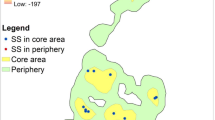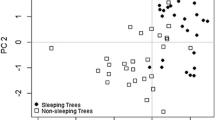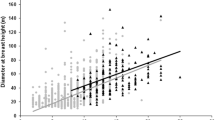Abstract
Arboreal primates spend about half of their lives at sleeping sites; hence, selection of sleeping sites is crucial for individual survival, and data concerning them is important for conservation efforts. We collected data on sleeping sites for a group of the endangered snub-nosed monkey (Rhinopithecus brelichi) at Yangaoping (27°58′N, 108°45′E) from January 2006 to December 2007. All sleeping sites were located in the mid-slope and in the shadow of ridges facing the northeast and southeast. The monkeys remained quiet while entering and occupying sleeping sites, and slept in evergreen species during the cold season (December–March). Trees in sleeping sites were similar in height and girth at breast height to those elsewhere, but some trees in lower areas were larger. The monkeys usually slept in close proximity to the last feeding spot, and their daily activities usually occurred around the sleeping site. Areas adjacent to sleeping sites were used more intensively than those not adjacent. Monkeys left the sleeping sites later in the morning in the cold season. These behavioral responses suggested that predation risk, thermoregulation, and climate stresses are the main determining factors in the selection of sleeping sites for this temperate monkey.




Similar content being viewed by others
References
Anderson, J. R. (1984). Ethology and ecology of sleep in monkeys and apes. In J. S. Rosenblatt, C. Beer & M. C. Busnel (Eds.), Advances in the study of behavior (Vol. 14, pp. 165–229). Philadelphia: Elsevier.
Anderson, J. R. (1998). Sleep, sleeping sites, and sleep-related activities: awakening to their significance. American Journal of Primatology, 46, 63–75.
Ansorge, V., Hammerschmidt, K., & Todt, D. (1992). Communal roosting and formation of sleeping clusters in Barbary macaques (Macaca sylvanus). American Journal of Primatology, 28, 271–280.
Aquino, R., & Encarnación, F. (1986). Characteristics and use of sleeping sites in Aotus (Cebidae: Primates) in the Amazon lowlands of Peru. American Journal of Primatology, 11, 319–331.
Bishop, N. H. (1979). Himalayan langurs: temperate colobine. Journal of Human Evolution, 8, 251–281.
Bleisch, W. V., Cheng, A. S., Ren, X. D., & Xie, J. H. (1993). Preliminary results from a field study of wild Guizhou snub-nosed monkeys (Rhinopithecus brelichi). Folia Primatologica, 60, 72–82.
Boggess, J. (1980). Intermale relations and troop male membership changes in langurs (Presbytis entellus) in Nepal. International Journal of Primatology, 1, 233–273.
Caine, N. G. (1987). Vigilance, vocalizations, and cryptic behavior at retirement in captive groups of red-bellied tamarins (Saguinus labiatus). American Journal of Primatology, 12, 241–250.
Caine, N. G., Potter, M. P., Mayer, K. E. (1992). Sleeping site selection by captive tamarins (Saguinus labiatus). Ethology 90, 63–71.
Chapman, C. A. (1989). Spider monkey sleeping sites: use and availability. American Journal of Primatology, 18, 53–60.
Chapman, C. A., Chapman, L. K., & McLaughlin, R. L. (1989). Multiple central place foraging by spider monkeys: travel consequences of using many sleeping sites. Oecologia, 79, 506–511.
Di Bitetti, M. S., Vidal, E. M. L., Baldovino, M. C., & Benesovsky, V. (2000). Sleeping site preferences in tufted capuchin monkeys (Cebus apella nigritus). American Journal of Primatology, 50, 257–274.
Eisenberg, J. F., Dittus, W. P. J., Fleming, T. H., Green, K., Struhsaker, T., & Thorington, R. W. (1981). Techniques for the study of primate population ecology (pp. 21–22). Washington: National Academy.
Fan, P. F., & Jiang, X. L. (2008). Sleeping sites, sleeping trees, and sleep-related behaviors of black crested gibbons (Nomascus concolor jingdongensis) at Mt. Wuliang, Central Yunnan, China. American Journal of Primatology, 70, 153–160.
Fernadez-Duque, E., Rotundo, M., & Ramirez-Llorens, P. (2002). Enivironmental determinants of birth seasonality in night monkeys of the Argentinean Chaco. International Journal of Primatology, 23, 639–656.
Furuichi, T., & Hashimoto, C. (2004). Botanical and topographical factors influencing nesting-site selection by chimpanzees in Kalinzu Forest, Uganda. International Journal of Primatology, 25, 755–765.
Furuichi, T., Takasaki, H., & Sprague, D. S. (1982). Winter range utilization of a Japanese macaque troop in a snowy habitat. Folia Primatologica, 37, 77–94.
Gittins, S. P. (1982). Feeding and ranging in the agile gibbon. Folia Primatologica, 38, 39–71.
Heymann, E. W. (1995). Sleeping habits of tamarins, Saguinus mystax and Saguinus fuscicollis (Mammalia; Primates; Callitrichidae), in north-eastern Peru. Journal of Zoology, 237, 211–226.
IUCN. (2007). IUCN Red List of Threatened Species. IUCN, Gland, Switzerland and Cambridge, UK. Retrieved from http://www.iucnredlist.org (Accessed February 20, 2008).
Kirkpatrick, R. C. (1996). Ecology and behavior of the Yunnan snub-nosed langur (Rhinopithecus bieti, Colobinae). Ph.D. dissertation., University of California, Davis.
Li, B. G., Chen, C., Ji, W. H., & Ren, B. P. (1999). Seasonal home range changes of the Sichuan snub-nosed monkey (Rhinopithecus roxellana) in the Qinling Mountains of China. Folia Primatologica, 71, 375–386.
Liu, Z. H., & Zhao, Q. (2004). Sleeping sites of Rhinopithecus bieti at Mt. Fuhe, Yunnan. Primates, 45, 241–248.
Nie, S. G., Xiang, Z. F., Li, M., & Wei, F. W. (2009). Preliminary reports on diet and social structure of gray snub-nosed monkeys (Rhinopithecus brelichi) at Yangaoping, Guizhou. Acta Theriologica Sinica, 29, 326–331.
Oates, J. F. (1987). Food distribution and foraging behavior. In B. B. Smuts, D. L. Cheney, R. M. Seyfarth, R. W. Wrangham & T. T. Struhsaker (Eds.), Primate societies (pp. 197–209). Chicago: The University of Chicago Press.
Phillips, E. A. (1959). Methods of vegetation study. New York: Holt, Rinehart and Winston.
Reichard, U. (1998). Sleeping sites, sleeping places, and presleep behavior of gibbons (Hylobates lar). American Journal of Primatology, 46, 35–62.
Suzuki, A. (1965). An ecological study of wild Japanese monkeys in snowy areas-focused on their food habits. Primates, 10, 103–148.
Wada, K., & Ichiki, Y. (1980). Seasonal home range use by Japanese monkeys in the Shiga Heights. Primates, 21, 468–483.
Wada, K., & Tokida, E. (1981). Habitat utilization by wintering Japanese monkeys (Macaca fuscata fuscata) in the Shiga Heights. Primates, 22, 330–348.
Xiang, Z. F. (2005). The ecology and behavior of black-and-white snub-nosed monkeys (Rhinopithecus bieti, Colobinae) at Xiaochangdu in Honglaxueshan National Nature Reserve, Tibet, China. Ph.D. dissertation, Chinese Academy of Sciences. Kunming Institute of Zoology, Kunming.
Xiang, Z. F., Nie, S. G., Chang, Z. F., Wei, F. W., & Li, M. (2009). Current status and conservation off the gray snub-nosed monkey Rhinopithecus brelichi (Colobinae) in Guizhou, China. Biological Conservation, 142, 469–476.
Yang, Y. Q., Lei, X. P., & Yang, C. D. (2002). Fanjingshan Research: Ecology of the wild Guizhou snub-nosed monkey Rhinopithecus bieti. Guiyang: Guizhou Science. in Chinese.
Zhao, Q. K. (1999). Responses to seasonal changes in nutrient quality and patchiness of food in a multigroup community of Tibetan macaques at Mt. Emei. International Journal of Primatology, 20, 511–524.
Zhao, Q. K., & Deng, Z. Y. (1988). Ranging behavior of Macaca thibetana at Mt. Emei, China. International Journal of Primatology, 9, 37–47.
Zhu, S. Q., & Yang, Y. Q. (1990). Forest types of Mt Fanjing. In Z. X. Zhou & Y. Q. Yang (Eds.), Research on the Mt Fanjing (pp. 95–222). Guiyang: Guizhou People’s Publishing House. in Chinese.
Acknowledgments
The National Basic Research Program of China (2007CB411605), the National Natural Science Foundation of China (30630016, 30870375), the Innovation Project of the Chinese Academy of Sciences (KSCX2-YW-R-091), the China Postdoctoral Science Foundation, the National Geographic Society (8575-08), and the Central South University of Forestry & Technology supported this study. We thank Professor Colin Groves and Dr. Ken Sayers for language editing of the manuscript, the editor and anonymous reviewers for invaluable suggestions on both the science and language, the Administrative Bureau of Fanjingshan Nature Reserve for their support, and X. G. Yang, S. J. Yang, and X. H. Dong for field assistance.
Author information
Authors and Affiliations
Corresponding author
Rights and permissions
About this article
Cite this article
Xiang, ZF., Nie, SG., Chang, ZF. et al. Sleeping Sites of Rhinopithecus brelichi at Yangaoping, Guizhou. Int J Primatol 31, 59–71 (2010). https://doi.org/10.1007/s10764-009-9378-6
Received:
Accepted:
Published:
Issue Date:
DOI: https://doi.org/10.1007/s10764-009-9378-6




